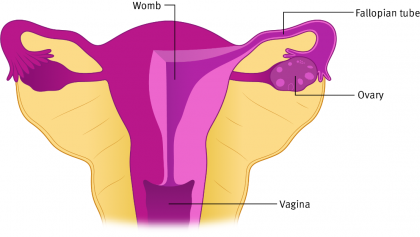Understanding the type of cancer (the histological type) can help you when discussing your diagnosis, treatment and prognosis with your specialist. But you may not wish to know so much detail – it's a personal choice.
There are several different ovarian cancer types, named after the types of cells and tissue they start from. Your age can affect whether you get these different types of ovarian tumours. The type of ovarian cancer you have may affect your treatment options now and in the future.
Ovarian tumours tend to develop from three kinds of tissue.
Approximately 9 in 10 ovarian tumours come from epithelial cells, which form the surface layer covering the ovaries. Epithelial cell tumours (sometimes referred to as carcinomas) usually happen in those over 50 years old.
1 in 20 ovarian tumours come from the germ cells. Germ cells in the ovary are the cells that develop into eggs. Germ cell tumours usually happen in those who are younger.
Around 1 in 20 ovarian tumours come from the stromal cells (these cells make up the core of the ovaries). Stromal cell tumours may develop at any age. But certain tumours may be more common in adolescence (between childhood and adulthood). Granulosa cell tumours are an example of a stromal cancer.
There are also rarer types of ovarian cancer, for example sarcomas, which start from the connective tissue within the ovary.

Some cancer is now being categorised as fallopian tube cancer instead of ovarian cancer. Recent research showed that some ovarian cancers start growing from the fallopian tubes. Fallopian tube cancer is treated in the same way as ovarian cancer and is usually included in ovarian cancer clinical trials.
Primary peritoneal cancer (PPC) is also often treated in the same way as ovarian cancer as it’s believed to be the same disease. PPC starts in the peritoneum, a large, thin, flexible sheet of tissue that covers the organs inside your tummy (abdomen).
Last reviewed: April 2022
To learn more about our review process, take a look at our information standards.


